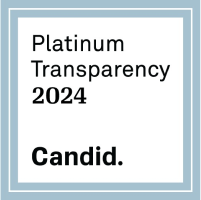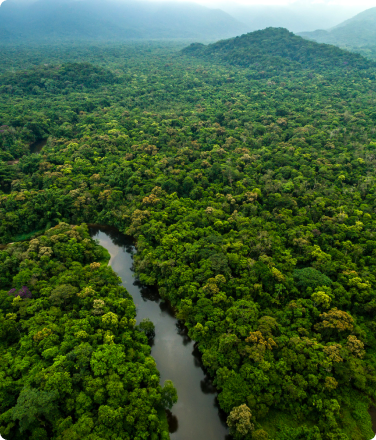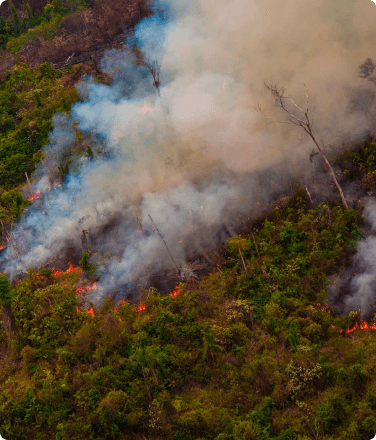Edico Cuelo stands in his shop in Puerto Alegre, Peru. Cuelo’s is the only shop in town, but—with resources in the community so scarce—business is slow.
- Rainforest Foundation US has begun an unprecedented program of direct finance forest defense, wherein indigenous communities are financially rewarded for successfully protecting their territories against deforestation.
- These payments are then used by the communities to better improve livelihoods.
- In Puerto Alegre, on the Amazon River in Northern Peru, community members speak about the tremendous vulnerabilities confronting them.
Puerto Alegre lacks a port, despite a name that implies otherwise. When coming to the village by boat—the only way to get to Puerto Alegre—the only way up onto dry land is via a series of dirt steps cut into the steep riverbank, which soften and collapse in times of heavy rain. There is no electricity in Puerto Alegre, either. No running water. The school only teaches up to the fifth grade, and the closest hospital is several hours’ boat ride away. There is a singular shop, run by 52-year-old Edico Cuelo and his 50-year-old wife, Yolanda, but in such an impoverished community there are no customers for the store’s scant offerings: crackers, pens, toothbrushes, plastic jewelry.

The only thing the village has in obvious abundance is rainforest: Puerto Alegre is titled to nearly 8 ½ square miles (2,183 hectares) of fecund majesty, an Edenic respite of massive hardwoods: lupuna, capinuri, mata-mata. In their forest, metallic blue butterflies the diameters of baseballs flutter above a forest floor carpeted with the electric pink petals of the pomarosa tree.
But even this majestic forest is under threat.
“They came in 2015,” Edico says. “With tractors and with chainsaws. And they took the wood.”
Over the course of one year, a logging company cut down approximately 200 lupuna and capinuri trees. In exchange, they gave the villagers a chainsaw, a weed whacker, a 5000-volt generator, and approximately $1,500 dollars (which was divided amongst 42 families, for approximately $35 per family).
Learn more about how deforestation affects Peru’s indigenous communities.
It wasn’t a great deal for the villagers. Within a year, the Peruvian government fined them more than $12,000 for deforestation. And the generator never worked.
“We tried it again and again,” Edico says. “We still have it somewhere.”
It might seem shocking to imagine the indigenous peoples of Puerto Alegre taking part in such an arrangement. After all, indigenous peoples in forest communities often have a respect for their environment that surpasses that in the industrialized north, and countless studies have shown that indigenous peoples better protect rainforests than other forest protection efforts—including national parks. But many indigenous communities are desperate, and feel strong-armed into agreements that destroy their forest territories.
By providing direct finance to indigenous communities on the frontlines of forest defense, Rainforest Foundation US is attempting to address both issues. When villages implement the satellite-based forest patrol program (“Rainforest Alert”), they’re paid by the hectare, every six months, for the forest that they keep standing.That money can be used however the community chooses—provided that the community spends it on something that benefits the entire collective.
The technology works. In a pilot study of Rainforest Alert, communities reduced deforestation by more than 50% in a single year. Puerto Alegre was part of that pilot program, and so community members know they can succeed. As such, they immediately begin considering the best use of the investment.
Read more about why indigenous peoples are the best rainforest protectors.
Roni Dasilva, a 33-year-old forest patrol instructor, wants to invest the money in healthcare, to keep his 11-year-old daughter safe.

“She gets parasites from drinking bad water,” Dasilva says. “She loses her appetite. All she wants to do is sleep.”
According to Dasilva, there are 95 children between the ages of 0 and 12 in Puerto Alegre.
“Without drugs to treat them, these parasites start coming out their noses, start coming out their eyes. Sometimes the children die. We need better healthcare,” he says. Or, at the very least, an ambulatory speedboat to deliver the gravely ill to healthcare facilities.
Some imagine a more direct solution: potable drinking water, created through the construction of a drinking water well. Currently the village collects rainwater in massive black plastic barrels, which are positioned at the base of corrugated tin roofs. But when the dry season sets in, weeks can pass without rain, forcing the villagers to make untenable choices, like drinking from shrunken, muddy watering holes.
“It’s dirty,” says Cesar Mendez, 38 years old. “But we drink it all the same. What else are we going to do?”
Others like Manuel Cuehlo, a 48-year-old forest patroller, argue that the money could be used as an investment that generates more wealth.
“What we need is camu-camu,” Cuehlo says—a small tree which produces cherry-like fruit. “If we get camu-camu, we can sell it in [the city of] Iquitos. We could sell it by the kilo. Moriche palm fruit, too. That’d grow our economy.”
Still others have more humble plans. The shopkeeper, Edico, is still hoping the village eventually gets a generator.
“It’d be nice,” says Edico. “With a generator, we could have refrigeration. Then we could freeze our fish and chicken. Maybe we could sell those too.”






